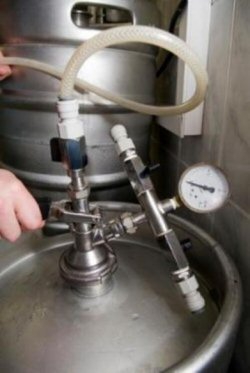
Topics include:
- What should be looked at?
- Training
- Keg and gas bottle storage
- Pipeline Cleaning
- Falls from Height
- Manual Handling
What should be looked at?
- a CO2 gas sensor is desirable because gas leaks are not visible and can cause death through asphyxiation – CO2 is heavier than air and will accumulate at floor level
- positioning of the delivery vehicle, which should allow access to the premises for the movement of barrels, crates, bottles and CO2 cylinders
- a notice showing where the CO2 cylinders are stored, including any bulk or “cryoserve” CO2 reservoir cylinders
- members of staff must be properly trained to connect and disconnecting cylinders to avoid cross-threading valve damage and gas leakage
- empty and full CO2 cylinders must be secured, or chained, to prevent damage
- a written procedures for the safe delivery and collection of barrels, kegs, cylinders, bottles etc. which must be enforced
- delivery or collection operations, ensure hatches, cellar flaps or trapdoors are secured open, cordon off the area and use warning signs
Training
All staff and volunteers involved in cellar work should be provided with information and training on the aspects of cellar management. All training should be recorded. Staff should sign to confirm that they have received their specific training. They should be trained on:
- safe systems of work including CO2 detection and leakage procedures
- CO2 cylinder connection and disconnection procedures and
- manual handling/ safe lifting techniques
- All training should be recorded. Staff should sign to confirm that they have received their specific training
Keg and gas bottle storage
The following points should be adhered to when storing kegs and gas bottles:
- managers normally hold access keys
- only authorised staff have access to storage areas
- only trained and competent staff make adjustments and connections
- kegs and casks stored above freezing should ideally be 11-14ᵒC
- unused cylinders are stored horizontally with a wedge or upright, secured with a chain, and away from any heat sources
- connected cylinders are kept upright and secured with a chain
- smoking must be prohibited
- Cellar warning card(s) are displayed near cylinders
- gas cylinders only transported in ventilated vehicles
- CO2 cylinders tested every 5 years
- staff advised not to handle frosted cylinder(s)
- staff not to enter any area that contains a high concentration of gas
- secondary reducing valves set by fitters for individual products and not tampered with by staff
- drip tray contents not emptied back into kegs/casks
- regular spot checks by manager to ensure existing measures are being used
- carry out a risk assessment for the possible need to fit gas monitors must be carried out
- action plan in case of a gas leak to be formulated ASAP i.e. informing staff to turn off gas if possible and ventilate area and to contact cellar service if leak is serious
- when cellar flaps/trapdoors are open, supervision is needed to stop anyone falling in, also to stop unauthorised access to the cellar or theft
- flaps/trapdoors/hatches must be regularly checked and maintained to keep them in good condition - the bolts or fastenings must stop them closing accidentally
- where possible, separate designated storage areas should be identified for the different kegs, cylinders, bottles, rubbish etc. while limiting manual handling as much as possible and keeping areas well organised to allow access
- provide suitable rigid plastic bins/containers for the collection and storage of broken glass and instruct all staff to use them
- adequate lighting and ventilation must be provided
- provide suitable low headroom warning notices, insulation, padding etc., and, where necessary, draw attention to low beams, light fittings or fluorescent tubes in the premises
Pipeline Cleaning
- only trained and competent staff should be allowed to use beer line cleaner
- gloves, goggles and apron should be provided and worn
- all pipes cleaned at least every seven days to prevent a build up of yeast and bacteria, ensuring good hygiene practices
- staff must be aware of the contents and location of the Material Safety Data Sheets
- pipes should be cleaned using detergent at the manufactures recommended strength and contact time
- a ‘Danger Pipe Cleaning in Progress’ notice displayed in a prominent place when cleaning pipes
- pipe cleaning detergent must never sit in pipes during trading hours
Falls from Height
- access to the cellar hatch area should be restricted when in use
- hatch only opened when bar closed to the public and all staff in premises advised hatch is open
- sufficient lighting on cellar steps and in cellar
- handrails leading to cellar kept in good condition
Manual Handling
- deliveries at back of premises as close to cellar as practically possible
- limit lifting for expectant mothers
Example Risk Assessment Template
Email: health.safety@dundeecity.gov.uk
Tel: 01382 433710 Option 6

